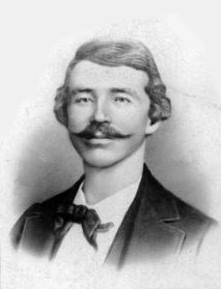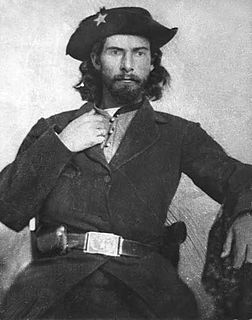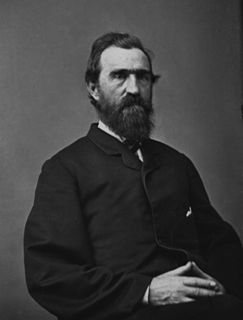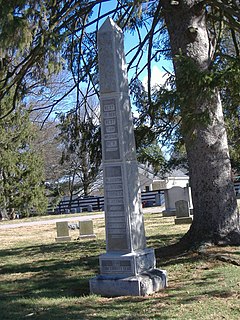
Alexander Franklin "Frank" James was a Confederate soldier, guerrilla, and outlaw. He was the older brother of outlaw Jesse James and was also part of the James–Younger Gang.

William Clarke Quantrill was a Confederate guerrilla leader during the American Civil War.

Manton is an unincorporated community in the central part of the U.S. state of Kentucky, located on the western edge of Washington County near the intersection of Marion, Nelson, and Washington counties. It was founded at least before 1844, when Holy Rosary Church was founded. The cornerstone for the present church was laid November 2, 1844. Holy Rosary, a mission church, is a brick building on Hardin's Creek close to the Beech Fork River.

The 5th United States Colored Cavalry was a regiment of the United States Army organized as one of the units of the United States Colored Troops during the American Civil War. The 5th USCC was one of the more notable black fighting units. It was officially organized in Kentucky in October 1864, after its first two battles. It was commanded by Colonel James Brisbin until February 1865, when he took over the 6th US Colored Cavalry. His executive officer, Louis Henry Carpenter, commanded the regiment until 20 March 1866.

Bushwhacking was a form of guerrilla warfare common during the American Revolutionary War, American Civil War and other conflicts in which there were large areas of contested land and few governmental resources to control these tracts. This was particularly prevalent in rural areas during the Civil War where there were sharp divisions between those favoring the Union and Confederacy in the conflict. The perpetrators of the attacks were called bushwhackers. The term "bushwhacking" is still in use today to describe ambushes done with the aim of attrition.

Stephen Gano Burbridge, also known as "Butcher" Burbridge or the "Butcher of Kentucky", was a controversial Union general during the American Civil War. In June 1864 he was given command over the Commonwealth of Kentucky, where guerrillas had carried out attacks against Unionists. He imposed martial law and was criticized for punitive actions against persons accused of being guerrillas.

Thomas Elliott Bramlette was the 23rd Governor of Kentucky. He was elected in 1863 and guided the state through the latter part of the Civil War and the beginning of Reconstruction. At the outbreak of the war, Bramlette put his promising political career on hold and enlisted in the Union Army, raising and commanding the 3rd Kentucky Infantry. In 1862, President Abraham Lincoln appointed him district attorney for Kentucky. A year later, he was the Union Democrats' nominee for governor. Election interference by the Union Army gave him a landslide victory over his opponent, Charles A. Wickliffe. Within a year, however, federal policies such as recruiting Kentucky Negroes for the Union Army and suspending the writ of habeas corpus for Kentucky citizens caused Bramlette to abandon his support of the Lincoln administration and declare that he would "bloodily baptize the state into the Confederacy".

Kentucky was a border state of key importance in the American Civil War. President Abraham Lincoln recognized the importance of the Commonwealth when, in a September 1861 letter to Orville Browning, he wrote:
I think to lose Kentucky is nearly the same as to lose the whole game. Kentucky gone, we cannot hold Missouri, nor Maryland. These all against us, and the job on our hands is too large for us. We would as well consent to separation at once, including the surrender of this capitol.

Louisville in the American Civil War was a major stronghold of Union forces, which kept Kentucky firmly in the Union. It was the center of planning, supplies, recruiting and transportation for numerous campaigns, especially in the Western Theater. By the end of the war, Louisville had not been attacked once, although skirmishes and battles, including the battles of Perryville and Corydon, took place nearby.

Marcellus Jerome Clarke was a Confederate captain who in 1864 became one of Kentucky's most famous guerrillas. He was rumored to be "Sue Mundy", a character publicized by George Prentice, editor of the Louisville Journal.

Hugh Boyle Ewing,, was a diplomat, author, attorney, and Union Army general during the American Civil War. He was a member of the prestigious Ewing family, son of Thomas Ewing, the eldest brother of Thomas Ewing, Jr. and Charles Ewing, and the foster brother and brother-in-law of William T. Sherman. General Ewing was an ambitious, literate, and erudite officer who held a strong sense of responsibility for the men under his command. He combined his West Point experience with the Civil War system of officer election.

George Dennison Prentice was a newspaper editor, writer and poet who built the Louisville Journal into a major newspaper in Louisville, Kentucky, and the Ohio River Valley, in part by the virulence and satire in its editorials, which some blamed for a bloody election day riot in 1855. A slaveholder, Prentice initially supported Unionist candidate John Bell in the 1860 U.S. Presidential election, and after the American Civil War began urged Kentucky to remain neutral. Both of his sons joined the Confederate States Army, one dying in 1862, and Prentice's editorials lampooned Kentucky's military governor, Union General Stephen G. Burbridge. Prentice later opposed Congressional Reconstruction. He wrote a biography of Henry Clay published in 1831, an 1836 poem published in the McGuffey Readers, and a collection of his humorous essays was published in 1859 and revised after his death.

The Martyrs Monument in Midway, located in Midway City Cemetery outside Midway, Kentucky, was placed on the National Register of Historic Places on July 17, 1997, as part of the Civil War Monuments of Kentucky Multiple Property Submission. It honors four Confederate prisoners who were killed due to the standing order of Union General over Kentucky Stephen G. Burbridge, known as Order No. 59, which declared: "Whenever an unarmed Union citizen is murdered, four guerrillas will be selected from the prison and publicly shot to death at the most convenient place near the scene of the outrages." The Confederate prisoners, whose names were M. Jackson, J. Jackson, C. Rissinger, and N. Adams, were executed on November 5, 1864 northeast of Midway, the precise location of which is unknown. This was due to the actions of Sue Mundy, a former trooper under John Hunt Morgan who terrorized Union forces in Kentucky during the later years of the American Civil War. They were buried in shallow graves originally, then re-buried in a Presbyterian cemetery, and finally in 1890 moved to their current location, with the dedication of the Martyrs Monument.

The New Haven Battlefield is the area of American Civil War military engagements at the intersection of the Rolling Fork and the former Louisville and Nashville Railroad line between Knoxville and New Haven, Kentucky. The geographic area includes the James Howell Farm and additional combat areas of December 30, 1862.
The 26th Kentucky Volunteer Infantry Regiment was an infantry regiment that served in the Union Army during the American Civil War.
The 54th Kentucky Volunteer Mounted Infantry Regiment was a mounted infantry regiment that served in the Union Army during the American Civil War.
The 12th Kentucky Volunteer Cavalry Regiment was a cavalry regiment that served in the Union Army during the American Civil War.

The First Battle of Saltville was fought near the town of Saltville, Virginia, during the American Civil War. The battle over an important saltworks in town was fought by both regular and Home Guard Confederate units against regular Union troops, which included one of the few black cavalry units of the United States Colored Troops. The Union troops were led by Brig. Gen. Stephen G. Burbridge, then commander of US forces in the Commonwealth of Kentucky.
The Mason Henry Gang were bandits operating in Central and Southern California in 1864-1865. As the Civil War was in progress, they were able to pose as Confederate Partisan Rangers, and their original mission was to rid the area of (anti-slavery) Republicans. But when it became clear that the Confederate cause was lost, they turned to outlawry, plundering and killing without mercy.
Henry C. Magruder was a Confederate soldier and guerrilla during the American Civil War. Born in Bullitt County, Kentucky, he took part in several major Western theater, but he is best known for his fate as a guerrilla.













